A discussion on dual-rated cranes
20 October 2023
In the realm of construction, it is a real win when one piece of equipment performs the work of two. Such is the case for dual-rated boom trucks, which can work as a crane and an aerial work platform (AWP). This is an especially attractive concept in the utility industry, which often needs to lift gear and people.
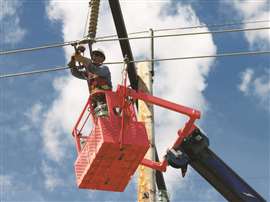 Dual-rated boom trucks and truck cranes can work as a crane and an aerial work platform (AWP). Photo: Diversified Products/Liftwise
Dual-rated boom trucks and truck cranes can work as a crane and an aerial work platform (AWP). Photo: Diversified Products/Liftwise
The concept of a dual-rated crane was first introduced in 2014 by Altec, a well-known supplier to the utility sector. Manitex International followed Altec into the market, and for a time Manitowoc’s National boom truck brand offered dual-rated cranes. Dual-rated cranes are primarily used in powerline construction, which routinely utilizes long reach cranes and aerials.
Single equipment solution
Altec saw the opportunity to better support the electric utility industry with a single equipment solution that would allow customers to utilize a boom truck to put personnel in the air, according to Zak Hilliard, Altec Cranes market manager. The Altec AC40-152S was the market’s first dual-rated boom truck.
“Since then, dual-rated products have gained wide popularity because they provide an economical, safe and efficient way to put people as high in the air as possible with a single product,” Hilliard said. “While there are other solutions that offer the same height, they can be prohibitively expensive. Also, dual-rated products allow you to save time on setup.”
Altec offers three dual-rated boom truck cranes. The latest addition is the AC65E-155S, which offers the highest capabilities of any dual-rated product on the market, Hilliard said. The AC40E-152S has a capacity of 40 tons and a platform capacity of 1,200 pounds. The AC45E-127S has a capacity of 45 tons and a platform capacity of 800 pounds. The new AC65E-155S has a capacity of 65 tons and a platform capacity of 1,200 pounds.
Expanding markets
“We’ve seen the adoption of dual-rated cranes into other markets,” Hilliard said. “Telecommunications customers have adopted them for tower erection and maintenance, especially as towers continue to get taller and heavier. We’ve also seen them used by customers in the lights and signs market, with a small number of tree care users adopting them, as well.”
 The latest addition to the Altec line of dual-rated cranes is the AC65E-155S, which offers the highest capabilities of any dual-rated product on the market, according to the company. The AC40E-152S has a capacity of 40 tons and a platform capacity of 1,200 pounds.
The latest addition to the Altec line of dual-rated cranes is the AC65E-155S, which offers the highest capabilities of any dual-rated product on the market, according to the company. The AC40E-152S has a capacity of 40 tons and a platform capacity of 1,200 pounds.
The safety, efficiency and cost savings make dual-rated boom trucks a popular solution with customers.
“Being dual-rated means that unit has to be designed and tested using two sets of design standards, which give the customer confidence it’s a safe solution in both work applications,” said Hilliard. “On the efficiency side, a test-lift is not needed when using a dual-rated crane for aerial work, only a test flight. These machines are cost effective and can allow customers to avoid the need for a specialized high-reach A92.2 rated-only aerial device.”
For a crane to be considered dual rated, it has to be configured with certain options.
“For the machine to use its dual rating, it has to have a platform attached to the boom or jib tip, and it has to have a radio remote, in addition to other unit features,” Hilliard said. “Each dual-rated crane product that Altec offers has its own specifically engineered platform to attach to it.”
Hilliard said Altec has seen strong demand in its core markets, and demand is increasing steadily in telecom applications. Altec recently improved its dual-rated product with the introduction of the E-Series control system. The electric-over-hydraulic controls allow for new levels of machine smoothness and predictability, as well as more predictable and consistent radio remote performance, Hilliard said. Altec also recently launched an insulating jib that is intended to be adapted to an A92.2 product.
Personnel lifting market
All boom truck manufacturers offer some type of personnel lifting device, whether it is using a dual-rated machine or a purpose-built aerial work platform. This has opened up the market for personnel platforms and man baskets.
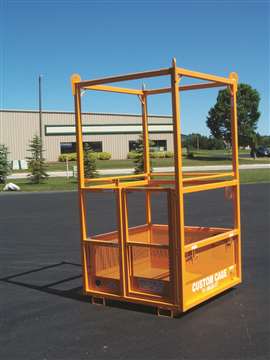 Lakeshore Industries
Lakeshore Industries
Kyle Haskell, owner, Lakeshore Industrial, said he would characterize the market for man baskets as “very random” in terms of busy versus slow periods but also very consistent year to year in terms of sales volume.
“We supply for all sorts of markets all over the world but the major markets are in construction and to crane and rigging companies,” he said. “At Lakeshore Industrial we have our standard models but we will also work to fit the needs of our customer as long as what they are asking for falls within OSHA standards.”
Diversified Product Development supplies products to adapt to more than 20 different manufacturers, said Heather Steele, marketing strategist.
“Our typical customer base is a mixture of equipment distributors and crane owners,” Steele said.
Based on its long history in the utility sector, Load King generally produces its own baskets for its product line. Vice President John Lukow said they offer a specialized luffing attachment for the PL-180 aerial that can be controlled from the operator’s station or via remote control.
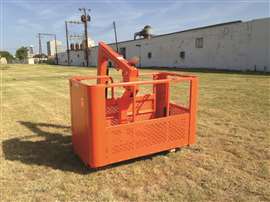 Diversified Products/LiftWise
Diversified Products/LiftWise
Elliott Equipment users prefer to outfit their Elliott cranes and aerials with Elliott OEM personnel platforms, the company said.
Altec produces its own line of propriety man baskets and related personnel lifting equipment.
Manitex also produces its own baskets that include a quick-attach feature as well as a 360-degree rotation.
Dual-rated cranes can be fitted with a variety of personnel lifters.
Voice of the customer
Manitex introduced its first dual-rated model, the TC50155HL, in 2015, after listening closely to the needs of customers, according to Sales Director Randy Robertson. Other models that followed include the TC45142/ TC40142, TC50155/TC50155HL and most recently the TC65131 and TC65159. All models feature a 1,200-pound quick attach basket.
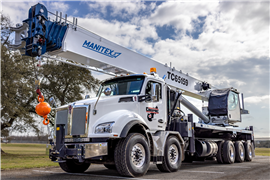 The Manitex TC65159 offers up to 214 feet of reach. Manitex makes its own proprietary 1,200-pound quick attach basket as well as a 360 degree rotation.
The Manitex TC65159 offers up to 214 feet of reach. Manitex makes its own proprietary 1,200-pound quick attach basket as well as a 360 degree rotation.
“Dual-rated boom trucks/truck-mounted cranes are a product of listening to the needs of contractors and fleet owners to provide more efficiency in the construction of new transmission lines, telecommunications upgrades and other hi reach applications,” Robertson said. “Manitex designed an exclusive solution for select TC Series models whereby the crane’s electro-hydraulic operating systems and software change internal parameters when personnel basket mode is selected.”
The TC65159 offers up to 214 feet of boom and the TC65131 up to 194 feet aerial working height when equipped with optional jib.
“Manitex produces its own proprietary baskets that include a quick attach feature making set up quick and efficient,” said Robertson. “The baskets also include 360-degree rotation with no external hydraulics or cable to tangle or leak.”
Market momentum
Robertson said the main markets for dual-rated boom trucks are in the power line construction and telecommunications sectors. The market for these units is growing and should expand even more with the federal infrastructure bill and those projects coming online. The legislation includes monies for thousands of miles of new transmission lines on new and existing right of way.
“Customers and fleet owners appreciate the dual-rating feature and how it improves job efficiencies and equipment utilization,” Robertson said. “Use of dual-rated cranes does not preclude the operator from performing an empty basket trial lift before lifting personnel.”
Depending on the user, Robertson said some do use the machine as an aerial device and crane on the same job on the same day.
“It all depends on the user and their own internal policies,” Robertson explained. “It is important to mention that dual rating features in no way substitute for proper and safe judgement, on-site planning, trial lifts and following all federal and local requirements.”
Not all boom truck manufacturers offer dual-rated products, and a couple of those that do not offer these machines have strong reasons for not entering this market.
The dual-rated crane discussion continues in our “On the flip side” article that follows.
On the flip side
Some boom truck manufacturers dispute the concept of a dual-rated crane, preferring to manufacture boom trucks and aerial devices as separate machines.
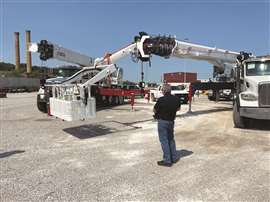 Elliott Equipment’s boom trucks are certified as ASME B30.5 mobile cranes, and its E-Line and HiReach aerials are certified as ANSI A92.2 vehicle-mounted aerial devices.
Elliott Equipment’s boom trucks are certified as ASME B30.5 mobile cranes, and its E-Line and HiReach aerials are certified as ANSI A92.2 vehicle-mounted aerial devices.
“To put dual-rating in context, one must understand the various standards and interests at play,” said Jim Glazer, president of Elliott Equipment. “ASME B30.5 is the standard for the design, inspection, testing, maintenance and operation of mobile cranes. ASME B30.23 is the standard that covers lifting people with cranes. ANSI A92.2 is the standard for the design, inspection, testing, maintenance and operation of vehicle-mounted aerial devices. ASME B30.5 (and ASME B30.23) and ANSI A92.2 are mutually exclusive standards and do not recognize each other. There is no industry guidance or regulation on what design or testing parameters apply to a dual-rated crane.”
OSHA requires that users perform a trial lift (using a platform with test weights to go through the flight path that personnel will use) and proof test, prior to lifting personnel with cranes.
Glazer said vehicle-mounted aerial devices have more stringent design standards for structural components, stability and hydraulic burst pressure among others, and that vehicle-mounted aerial devices are not generally exposed to the loading that cranes are. As a result, equipment originally designed as vehicle-mounted aerial devices and self-propelled work platforms are exempt from the OSHA Crane Standards.
Sticking with two machines
Glazer contends that there is no industry standard that covers the design, inspection, testing, maintenance and operation of a dual-rated crane.
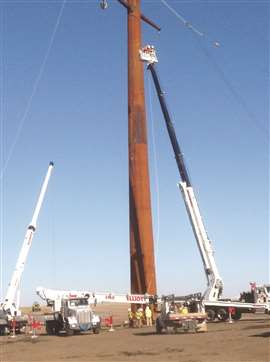 Load King offers a fully A92.2 compliant aerial called the PL-180. The PL-180 has a hand height of 180 feet, and is capable of material handling up to 2,000 pounds on the jobsite.
Load King offers a fully A92.2 compliant aerial called the PL-180. The PL-180 has a hand height of 180 feet, and is capable of material handling up to 2,000 pounds on the jobsite.
In the absence of an industry standard, “Elliott does not want to create a false sense of security or confuse the operator prior to lifting personnel with a crane and does not currently offer a dual-rated crane,” Glazer said. “Our boom trucks are certified as ASME B30.5 mobile cranes, and our E-Line and HiReach aerials are certified as ANSI A92.2 vehicle-mounted aerial devices.”
Load King, a division of Custom Truck One Source, also does not offer dual-rated machines.
“We believe that the A92.2 and B30.5 standards are incompatible within the same machine,” said John Lukow, senior vice president of Load King. “A machine should be designed, manufactured and operated under one or the other standard. Switching back and forth day to day or week to week is not rational. We believe the standards are clear. OSHA 29 C.F.R. section 1926.1431(h) requires operators conduct a trial lift before lifting personnel with a boom truck crane. However, section 1926.1401(c)(5) makes an exception for machinery originally designed as a vehicle-mounted aerial device. The dual-rated machines in the market are all originally designed and manufactured as B30.5 lifting cranes, and the dual rating is offered as an option for a fee.”
Load King does offer a fully A92.2 compliant aerial called the PL-180, which has a hand height of 180 feet, and is capable of material handling up to 2,000 pounds. And if after a number of years in service, the owner of a PL-180 aerial device wishes to convert their machine, Load King will do that.
“Load King offers a one-way conversion of the PL-180 into a 50-ton crane,” said Lukow. “The factory will provide updated load charts and remove the luffing attachment from the basket and perform stability testing of the machine to certify it as a B30.5 crane.”
The ‘dual-rating’ of cranes is a complex issue with no easy answers, according to Elliott’s Glazer.
“Ultimately, it is up to the equipment manufacturer to certify a machine to a specific standard,” he said.
STAY CONNECTED



Receive the information you need when you need it through our world-leading magazines, newsletters and daily briefings.
CONNECT WITH THE TEAM







